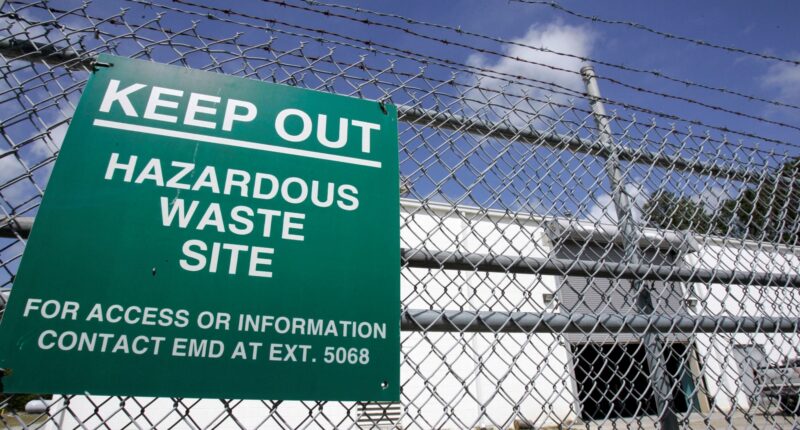The US Environmental Protection Agency on Monday banned the use of two ubiquitous cancer-causing solvents that activists have been targeting for decades.
The ban involves trichloroethylene, or TCE, a cancer-causing chemical that is common in manufacturing and can be found in water sources and properties around the world, as well as all consumer uses and many commercial uses of perchloroethylene, or PCE, a solvent used in industries such as dry cleaning, manufacturing, and automobile repair.
“It’s simply unacceptable to continue to allow cancer-causing chemicals to be used for things like glue, dry cleaning, or stain removers when safer alternatives exist,” Michal Freedhoff, assistant administrator for the EPA’s Office of Chemical Safety and Pollution Prevention, said in a news release.
The trouble with TCE
Since the 1920s, TCE has been one of the most frequently used solvents in industry. It’s a colorless volatile organic compound that manufacturers use as a cleaning agent and degreaser, mainly for metal. It is nonflammable, so it can also be used in paints, sealants, coatings and some auto products like brake cleaners. Companies that make refrigerants also use TCE.
Because it was so widely used, TCE has also become a significant contaminant in drinking water in the United States. Between 4.5% and 18% of the drinking water sources in the US that are tested on a yearly basis by the EPA have some TCE contamination, according to the US Centers for Disease Control and Prevention’s Agency for Toxic Substances and Disease Registry. The water systems serve about 19 million people.
Camp Lejeune, the Marine Corps base in North Carolina, is one community that was significantly affected by TCE contamination. From 1975 through 1985, a period in which the water at the base was known to be contaminated with volatile organic compounds, tests showed that TCE levels in the water were 70-fold higher than the permissible amount, a study found.
Marines who were stationed at at Camp Lejeune in this period had a 70% higher risk of Parkinson’s disease than those who served at a post across the country, research showed. The illnesses resulted in hundreds of thousands of claims against the federal government.
Even at small concentrations, TCE exposure is also known to cause cancer, non-Hodgkin lymphoma, problems with the nervous system and the immune system, reproductive problems, liver and kidney damage and other significant health issues.
Most people who are exposed to the chemical get it through their drinking water. Those who work with TCE can also face major health issues, according to the CDC.
Under the new ban, most uses of TCE will be prohibited within one year, though the EPA is still finalizing some of the details. There will be a limited number of situations in which workplaces will get more time to phase it out, but those workers will have rules in place for safe handling. Those exceptions will include some uses of TCE to clean aircraft parts and medical devices; its use in manufacturing battery separators and refrigerants; and in transportation, security and defense systems.
Some of the time frames were adjusted after the government received public comment suggesting that the phaseout would take extra time in some industries.
The problem with PCE
PCE is a human-made volatile liquid solvent used by dry cleaners, fabric finishers and metal manufacturers. It can be found in water repellents, silicone lubricants, spot removers, wood cleaners and glues.
It’s a popular cleaner because it is not flammable, but scientists have known for decades about its health concerns.
PCE, also called PERC or tetrachloroethylene, can cause a variety of cancers including brain, kidney, liver and testicular cancer. It can also damage the liver, the kidneys, the immune system, the nervous system and the reproductive system.
Most PCE exposure happens when it evaporates in the air, according to the EPA; it can also leak into the ground and contaminate drinking water, like TCE. People who are most likely to be exposed to it are those who work with it like dry cleaners, but those who live near work sites also are exposed to air with higher background levels of PCE.
More than 5% of the US population uses water from community systems that have a PCE concentration that exceeds government standards, according to government data.
The EPA is finalizing a 10-year phaseout of the solvent in dry cleaning in most cases. Compliance dates are dependent on when the dry cleaner bought the machines that use the chemical, with older machines being phased out sooner than newly bought ones.
The EPA said that many dry cleaners have already started to make the transition to other chemicals and that using PCE in “newly acquired dry-cleaning machines” would be banned after six months.
The EPA will require companies to rapidly phase out use of PCE in many industrial and commercial uses, most of which will be fully phased out in less than three years. The agency said most companies can use alternative products that are already on the market.
Workplaces that are important to national security, aviation and critical infrastructure will be allowed to use PCE in controlled situations, according to the EPA, but there will have to be strict worker protection rules in place.
Rules passed in the final days of a presidential administration are subject to the Congressional Review Act, which would allow the incoming Senate to overturn the new regulations.
The Environmental Working Group, an organization that has been advocating for a ban on TCE for years, said the ban is a “crucial victory” in efforts to tackle the health harms it can cause.
“The EPA’s final rule will help to finally end most uses of this dangerous chemical,” said Dr. Tasha Stoiber, a senior scientist with the organization.

















